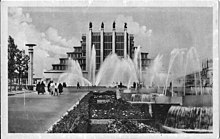Brussels World's Fair 1935
| World Exhibition Brussels 1935 Exposition universelle et international Brussels 1935 |
|
|---|---|
 The " Grand Palais " of the 1935 World's Fair |
|
| General | |
| Exhibition space | 125 ha |
| new hits | Traffic lights |
| Number of visitors | 20,000,000 |
| BIE recognition | Yes |
| participation | |
| countries | 24 countries |
| Exhibitors | 9,000 exhibitors |
| Place of issue | |
| place | Brussels |
| terrain |
Heyselpark coordinates: 50 ° 53 ′ 50 ″ N , 4 ° 20 ′ 21 ″ E |
| calendar | |
| opening | April 27, 1935 |
| closure | November 25, 1935 |
| Chronological order | |
| predecessor | Chicago 1933 |
| successor | Paris 1937 |
The 1935 World Exhibition in Brussels ( French Exposition Universelle et Internationale de Bruxelles 1935 ) was the 23rd world exhibition recognized by the Bureau International des Expositions (BIE) . Belgium's King Leopold III. opened the exhibition on April 27, 1935, which lasted until November 25, 1935. The Heyselpark was used as a 125 hectare exhibition area near the Royal Garden . With around 20 million visitors, the world exhibition was the best-attended exhibition that Belgium had hosted until then.
history
Originally, the world exhibition was to be held on the occasion of the 100th anniversary of Belgium's independence in 1930. The cities of Antwerp and Liège decided to organize a two-part exhibition for the national anniversary in 1930, so that the world exhibition in Brussels was postponed by five years. In 1935 Belgium and Brussels also celebrated two anniversaries: 50 years ago Belgium, resp. King Leopold II used the Congo as a colony and 100 years ago the first railway line on the continent was opened in Brussels .
Exhibition area
The Heysel plateau with today's Heyselpark was chosen as the exhibition area . The main entrance to the exhibition grounds was in the south on Place Saint-Lambert / Sint-Lambertusplein. On the left of the main entrance was the park of attractions with restaurants and entertainment facilities, on the right was Old Brussels, a reconstruction of the city in the 18th century, which was populated with "residents" in historical costumes.
The pavilions of nations, companies and organizations were located on both sides of the Boulevard du Centenaire / Eeuwfeestlaan , which rose to the north, and east of it in Laken Park . The French pavilion was designed by Le Corbusier .
At the end of the boulevard was the Grand Palais / Grote Paleis (also known as Palais des Expositions ), the architectural highlight of the exhibition in Art Deco style. It consisted of a total of five exhibition halls with an administration building. In these halls were u. a. the Belgian section with exhibitions on railways, industry, art and trade.
Focus of the exhibition
One focus of the 1935 World Exhibition in Brussels was the use of artificial light: neon light was used creatively in a variety of ways. As innovations in transport were required traffic lights presented for pedestrians. Another focus was the innovations in radio and television technology . An internal railway line ran through the exhibition at stops connected to the city's tram network. The art exhibition featured works by contemporary artists such as Paul Delvaux , René Magritte , Francis Picabia and Pablo Picasso .
As in the previous world exhibitions, sporting events were part of the regular program. The Stade du Centenaire (later the Heysel Stadium and now King Baudouin Stadium ), designed by Joseph Van Neck and opened early in 1930, was used for this purpose. There was space for 75,000 spectators. Le Corbusier was involved in the design of the French Pavilion.
Reuse
The Grand Palais exhibition halls and grounds were reused for Expo 58 . With a few exceptions, the pavilions of the nations and companies were removed after the event.
Picture gallery
Web links
- World Exhibition Brussels 1935. Bureau International des Expositions (English). Retrieved March 23, 2017 .
literature
- Detlef Wienecke-Janz: The great chronicle of world history: National Socialism and World War II: 1933-1945 . Wissenmedia / Chronik-Verlag, Gütersloh / Munich 2008, ISBN 978-3-577-09076-6 .
- Winfried Kretschmer: History of the world exhibitions . Campus, Frankfurt am Main 1999, ISBN 3-593-36273-2 .
- Monika Meyer-Künzel: Urban development of the world exhibitions and Olympic Games: urban development of the event locations . Dissertation Technical University Carolo-Wilhelmina, Braunschweig / Dölling and Galitz, Hamburg / Munich [i. e.] Ebenhausen near Munich, ISBN 3-933374-89-8 , p. 302–305 , urn : nbn: de: gbv: 084-120444 (1999/2000).






